Honor Award
Arizona State University Polytechnic Campus — New Academic Complex
Mesa, AZ
Ten Eyck Landscape Architects, Inc., Phoenix
Client: Arizona State University
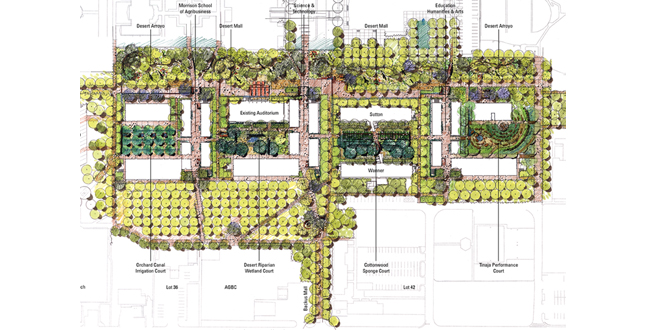
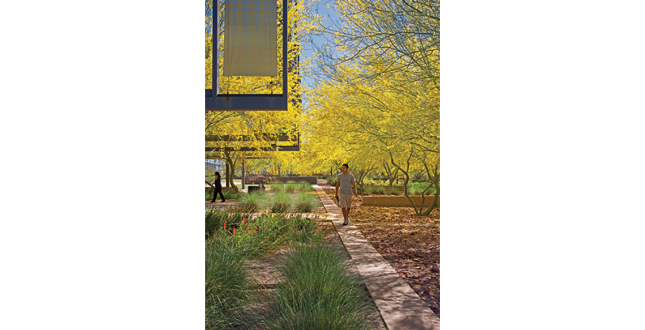 Close Me!
Close Me!This transformation of a former sterile air force base to a vibrant college campus is represented at the new student center where shaded dining terraces transition to desert gardens. Tertiary paths organize the planting while allowing desire lines.
Download Hi-Res ImageImage: Bill Timmerman
Image 2 of 16
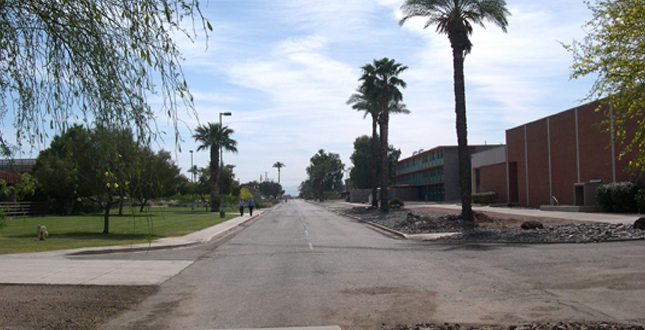 Close Me!
Close Me!Before: Shot of the core campus showing existing buildings to the left; the existing street that used to flood, and project site for the new buildings and renovated buildings to the right.
Download Hi-Res ImageImage: Bill Timmerman
Image 3 of 16
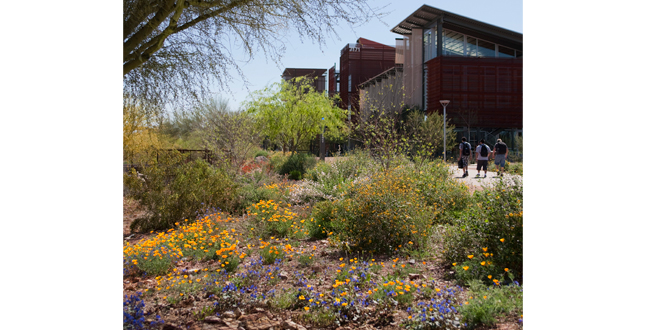 Close Me!
Close Me!After: Our team proposed to excavate the flooding street to create a Sonoran desert arroyo with a new campus mall that doubles as a fire lane along the new buildings on the right, with bridges connecting to the original campus core.
Download Hi-Res ImageImage: Bill Timmerman
Image 4 of 16
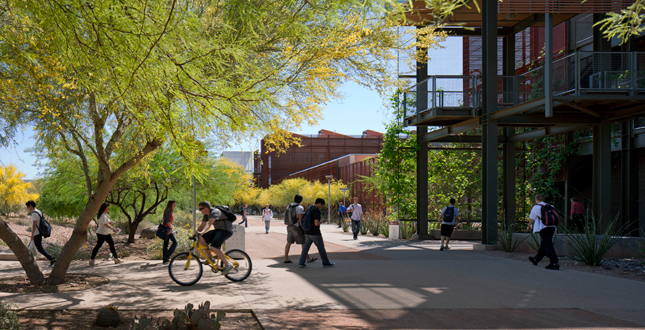 Close Me!
Close Me!Using a combination of concrete, and stabilized decomposed granite and offset planting for the mall reduces glare and helps with psychological cooling for desert dwellers.
Download Hi-Res ImageImage: Bill Timmerman
Image 5 of 16
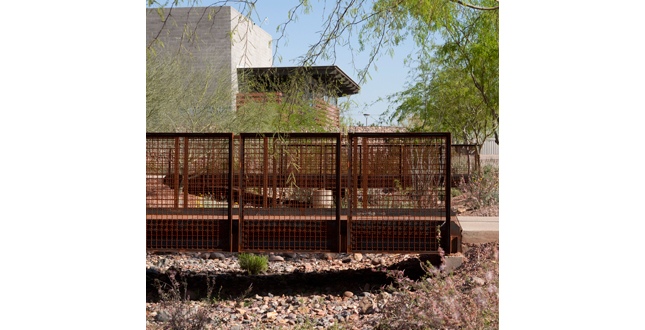 Close Me!
Close Me!The path of rain water is expressed through footbridges that also act as thresholds into campus courtyards.
Download Hi-Res ImageImage: Bill Timmerman
Image 6 of 16
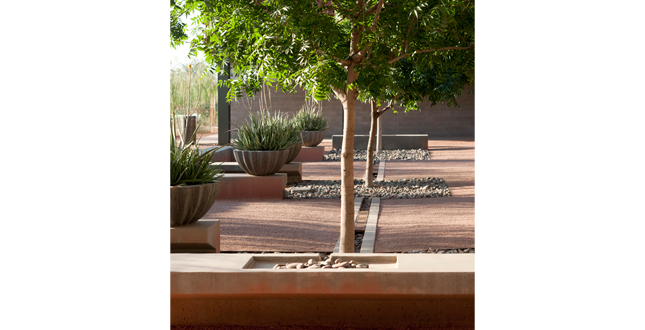 Close Me!
Close Me!The agribusiness courtyard is designed as an event gathering space and orchard with irrigation cistern seat walls and runnels as the organizing element conveying deep water when irrigating and the memory of water when dry.
Download Hi-Res ImageImage: Bill Timmerman
Image 7 of 16
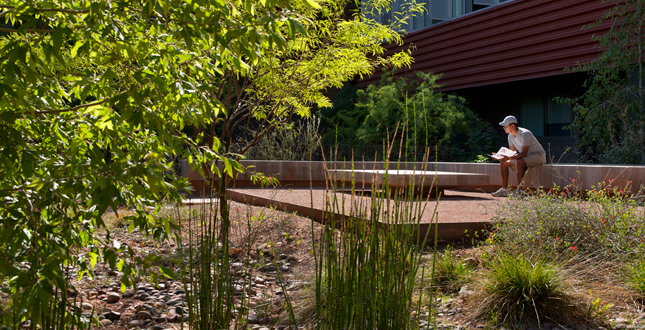 Close Me!
Close Me!This courtyard is surrounded by labs, and University faculty wanted to connect students to the natural environment. The courtyard was envisioned as an outdoor living laboratory with outdoor classroom study areas, a riparian living seep wall and irrigation cistern.
Download Hi-Res ImageImage: Bill Timmerman
Image 8 of 16
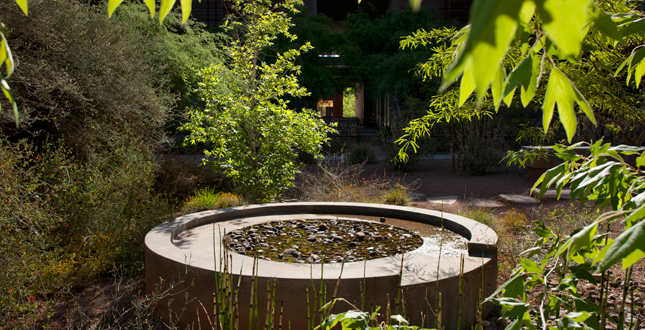 Close Me!
Close Me!The living wall to the left screens the outdoor classroom from a major walkway. The microclimate created by the buildings, living wall, ephemeral seep and native riparian plants suggest the sheltered feeling of an Arizona canyon.
Download Hi-Res ImageImage: Bill Timmerman
Image 9 of 16
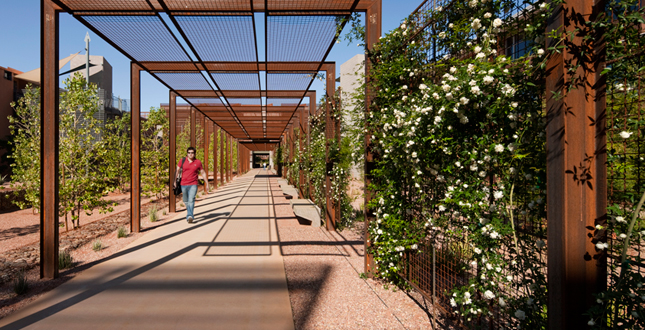 Close Me!
Close Me!A former parking lot between two existing buildings, the cottonwood canal courtyard conveys water along with the new arbor that guides people through the space.
Download Hi-Res ImageImage: Bill Timmerman
Image 10 of 16
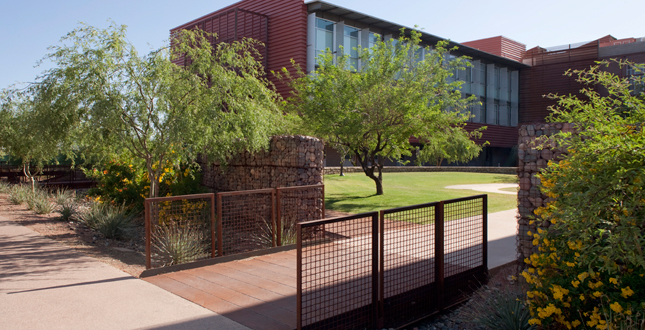 Close Me!
Close Me!The last courtyard, next to a renovated theater with new buildings to the south and west, is an amphitheater formed with salvaged concrete retaining walls and gabion courtyard walls filled with river rock salvaged from the site.
Download Hi-Res ImageImage: Bill Timmerman
Image 11 of 16
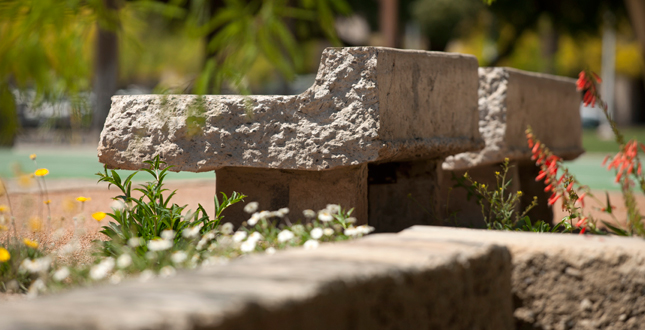 Close Me!
Close Me!Salvaged concrete and curbs were re-purposed throughout the project.
Download Hi-Res ImageImage: Bill Timmerman
Image 12 of 16
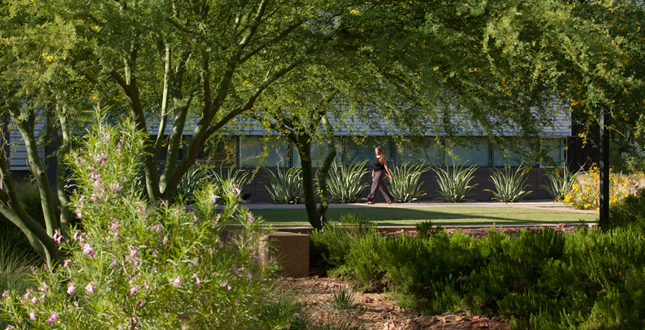 Close Me!
Close Me!In this microclimatic space, turf is judiciously used as the centerpiece, surrounded by ordered desert gardens.
Download Hi-Res ImageImage: Bill Timmerman
Image 13 of 16
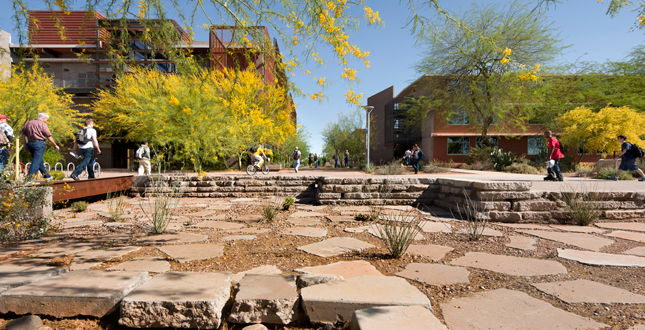 Close Me!
Close Me!Punctuated at a student crossing, an ephemeral path of water is created with salvaged concrete inter-planted with desert milkweed.
Download Hi-Res ImageImage: Bill Timmerman
Image 14 of 16
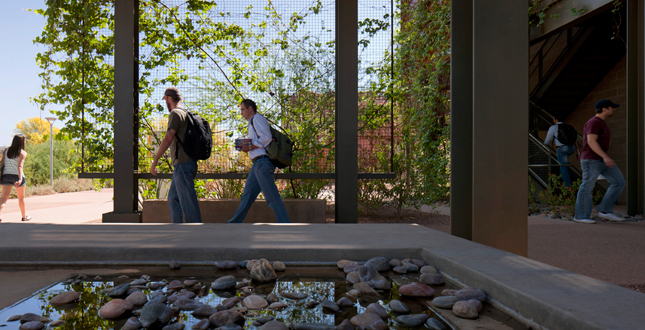 Close Me!
Close Me!We worked with the architect to transition from deep shade of the classroom building breezeways to the new mall using vine covered scrims and sheltered seating next to irrigation seeps.
Download Hi-Res ImageImage: Bill Timmerman
Image 15 of 16
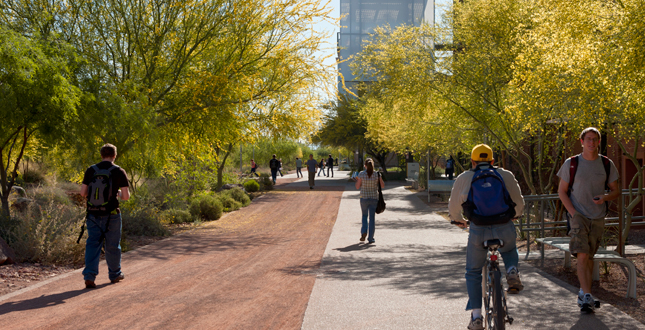 Close Me!
Close Me!A former barren, over-paved air force base is transformed into a Sonoran Desert campus oasis that is true to the region and an inspiring place to learn — campus enrollment has doubled since project completion.
Download Hi-Res ImageImage: Bill Timmerman
Image 16 of 16
Project Statement
The Arizona State University (ASU) Polytechnic Academic Campus project consists of 21 acres of site work in association with five new classroom building complexes. The goal was to transform the barren site of the former Air Force base into a thriving Sonoran Desert campus for learning. A major large asphalt street that formerly flooded during rains was transformed into a permeable, water harvesting arroyo adjacent to new campus malls and courtyards, giving students and faculty a daily connection to nature and each other while celebrating the path of precious, ephemeral rain water on campus.
Project Narrative
—2012 Professional Awards Jury
Design Context/ Design and Execution
Our interdisciplinary design team worked together with our client to seamlessly meld the new project with the existing campus and with each others’ scopes of work. ASU had struggled attracting students to this campus in part because of the oppressive over-paved ambience of the former air force base. The goal was to transform the perception and feel of the campus with this major new project. Our team reviewed the campus master plan which had a decidedly Ivy League approach to the campus design and developed a new master plan strategy for the project. We reinvented what a campus could be in the unique region of the Sonoran desert which only receives 7” of rainfall a year.
Inspired by our client’s need for storm water solutions and the Sonoran Desert’s arroyos, the design of the desert mall allows campus drainage to meander through a new, high performance, water cleansing native landscape adjacent to new major east west pedestrian circulation through the campus. Stabilized decomposed granite walkways in combination with desert shade trees help to reduce the urban heat island effect while the judicious use of textured concrete paving ensures ADA accessibility and proper emergency access required for a campus setting. Salvaged desert trees and small native shrubs, cacti and seed were used to create the arroyo habitat. During a rain event the arroyo captures and slows the storm water providing supplemental deep watering to the vegetation while lessening the effect of run-off to downstream offsite properties by retaining water within this historically troublesome, flood prone area. The desert mall is the heart and identity of the Polytechnic campus and will eventually be repeated on the north end of the campus core to replace yet another asphalt road with similar impervious and flooding challenges.
Each individual building courtyard is designed to relate to the schools program housed within and to take advantage of the microclimates created by the buildings. The Morrison School of Agribusiness courtyard includes a series of irrigation canals that feed an orchard court recalling the agricultural heritage and irrigation of the East Valley. The School of Science and Technology courtyard is shaped by a living wall planted with native vegetation adjacent to an irrigation seep, creating a periodic water event similar to those found in Arizona canyons. In addition, outdoor classrooms are designed into the space. Shaped by an amphitheater built from recycled sidewalks, the Education Humanities and Art courtyard includes a lawn gathering space to view performances. The backdrop to the amphitheater is freestanding gabion wall filled with the abundance of existing river rock from the site. Serving as a pedestrian link between administrative offices, the Wanner Sutton canal courtyard transports students through a shade structure tunnel that will soon be covered with vines. The courtyard exhibits native riparian trees and vegetation made possible by the collection and retention of storm water collected from the adjacent buildings.
Environmental Sensitivity and Sustainability
Situated on the former Williams Air Force Base, the existing conditions consisted of acres of asphalt, extensive concrete sidewalks and expanses of river rock covered ground. These materials were re-used for new outdoor spaces and parking areas. Harvested concrete paving was transformed into campus seating elements and retaining walls throughout the project. Existing river rock was used in gabions to construct both freestanding and retaining walls to create another layer of enclosure to the courtyards.
The project increased biomass, permeability and urban wildlife for the campus. Drought tolerant native plants were woven together with judicious hardscape to create comfortable, cooler spaces throughout to encourage social interaction and human comfort. The landscape nourished by storm water also provides habitat for desert fauna that visit the site. A state of the art drip irrigation system was used to allow many of the zones to eventually be turned off completely of water.
Design Value to Client and Other Designers
Our budget for the 21 acre project for landscape architecture was 5 million including demolition and utilities. Using this very modest per acre budget we created new student malls, courtyards and gardens while transforming storm water problems into an underlying concept for the entire project site design uniquely suited for our region. Some might say ‘why is storm water important when you get rain so infrequently?’ Our response is that it is even more important because the path of ephemeral water in the desert — the arroyo — is the sustaining life force of the desert and urban dwellers that call it their home. Economically the value for our client ASU is that we wisely stretched their dollars for maximum impact. Since the project was completed enrollment at the campus has increased by 20 percent as more students seek out this desert learning oasis.
Rich Stanley, Senior Vice President & University Planner for ASU said “The landscape design and the new buildings have transformed a campus that struggled to escape its image as a former air force base into a place recognized as great emerging university campus that is as attractive and innovative as the polytechnic innovation programs offered. The combination of the environment and the programs have allowed substantial enrollment growth and the initiation of a new student residential program. The Polytechnic landscape theme is now referenced as a goal for some of our new projects. The campus planning at Lake Havasu City and in downtown Chandler have both used the Polytechnic Campus to help guide the landscape plans.”
Project Resources
Landscape Architect: Ten Eyck Landscape Architects, Inc.
Project Principal: Christine E. Ten Eyck, FASLA; Project Manager: Roger Socha, ASLA; Project Landscape Architect: Judeen Terrey, ASLA; and Project Designers: Mike Chapman, Jeramy Beals, Matt Conn, Alyssa Priebe, and Trish Bigler
Design & Constuction Team
Architect
Lake | Flato
Architect
RSP Architects
Civil Engineer
Wood Patel and Associates
General Contractor
DPR, Inc.
Irrigation Design
Aqua Engineering
Landscape Contractor
ISS-Grounds Control
Structural Engineer
Paragon
Featured Products
ArtWeld gabions for retaining and freestanding walls
Hillfiker Retaining Walls
Enkamat Living Wall Soil Fabric
Colbond
Precast Concrete Urns
Kornegay Design
Stabilized Decomposed Granite
Stabilizer Solutions
Woven Wire Mesh for Bridges, Vine Scrims, and Arbors; 'Tread Plank' for Bridges
McNichols






